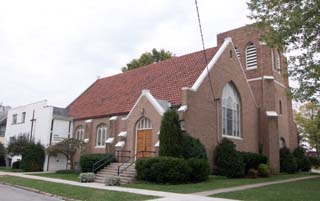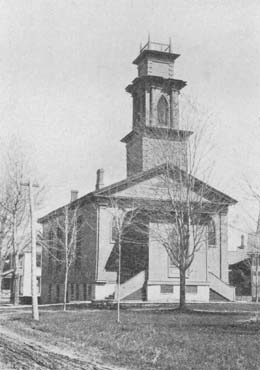
The Cornerstone Celebration at First Presbyterian Church, corner Routes 31 & 237 in Holley, will be Sunday, October 14, 10:30 a.m. to 3:30 p.m. Worship - 10:30 a.m.; Luncheon - Noon to 2 p.m.; Planting and dedication of tree - 1:45 p.m.; Bill Lattin, Orleans County Historian, “Stained Glass Windows - 2 p.m. Susan Machamer - organ history - 2:45 p.m.; Service and dedication of cornerstone box - 3 p.m.; everyone is welcome to join in the 100 year celebration events. Notes from the Historian The Passing of the Old Presbyterian Church calls out Further Reminiscences of Earlier Days Editor Standard: The Rev. Mr. Crampton, the pastor previous to Mr. Copeland, was a man of striking appearance, and of commanding dignity, enhanced by a heavy growth of snow white hair. On one occasion Mr. Copeland created an unexpected jolt in the congregation. While pressing the duty of giving for some special object, he made the inadvertent remark that the contribution from one side of the church was much larger than from the other. As every family had its well known pew, everyone at once knew which side it was. And for many years the two sides were “aristocratic” and “plebeian.” This finishes the historic church buildings of the village. There was a period while the old Baptist church was in a process of dilapidation that the Presbyterian house was the only representative of religion in Holley. In those ante-railroad days the views of boys as to things ecclesiastical were quite limited. On one occasion several of them were discussing the matter, and came to the conclusion that there were only two kids of churches in the world, the Baptist and Presbyterian, and, reasoning from their own observation, decided that the Presbyterian was much the largest body, because it happened to be the largest in the village. A bigger boy, just then dropping in, astonished them all by asserting that there was “no end of Catholics in the world.” There was a hazy idea that the “Episcopals” and the “Catholics” were about the same thing. And the only idea of Easter was a tradition about a day called “Paas Sunday” when eggs were to be eaten. When the new church is completed, Holley may well be proud of its fine array of church buildings, both in the matter of architecture and durability of structure. Between the village of the time of which we have been speaking and of today, there is a remarkable contrast. Just before the building of Rochester & Niagara Falls railroad was the lowest ebb of decadence and dilapidation. Empty houses, decrepit old houses, open spaces or “squares” distressfully untidy, depositories of accumulated refuse, on every hand. Frisbie’s and Buell’s stores at each end of the old brick block ad Frye’s drug store in the middle comprised the business houses. The only thing that broke into the sleep monotony of the summer days was the arrival of the packet on the canal, when not only the idlers and boys, but respectable citizens, made their way down to the canal bridge. The present time uniformly superior class of business houses, residences and public buildings which adorn the unique layout of the streets make Holley an exceptionally attractive village, and are a special joy to her wandering children when permitted to return. G.D.B. Miller, St. Louis, Clark Webster, Historian Editor’s Note: The Holley Standard publication quoted here is only one of the newspaper names owned by Westside News Inc. The West Edition of Suburban News bore the historic newspaper’s name along with the name of another western New York newspaper, the Brockport Republic-Democrat, when it first was introduced to western Monroe and eastern Orleans Counties in the late 1980s. “We weren’t born yesterday,” Westside News Inc. publisher Keith Ryan said of his publishing company’s long record of community service. © October 7, 2007 - Westside News Inc. |

